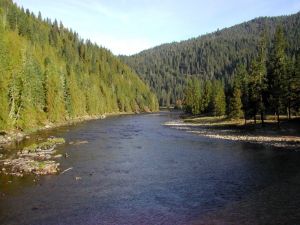Catastrophic Fresh Wave of Logging Threatens US National Forests

A fresh wave of logging is hitting America’s national forests, writes Brett Haverstick. But this time it’s all for the sake of ‘forest health’ and ‘fire prevention’. It might look like industrial clear-cutting to you and me, but really, it’s in a good cause. And if the forests and precious ecosystems they harbor just happen to perish in the process … well ain’t that just too bad?
National forests across the West are facing dire threats from politicians, the timber industry and the Forest Service.
The public is currently being misled into thinking that our forests are ‘unhealthy’, and that they need to be ‘restored’ due to ‘beetle infestations’ and ‘insects and disease’.
All of this is a euphemism to drastically ramp up logging on the forests.
America’s national forests are not unhealthy. Some people may want forests to look a certain way, but that desire or perception ignores scientific research, which suggests that fungi, bacteria, insects, disease and wildfire are key components of forest function and resiliency. If you want a healthy forest, these natural processes must be allowed to play out.
Efforts to ‘thin the threat’ and use thinning for ‘fire hazard reduction’ across Western landscapes is largely unsubstantiated in scientific literature.
Recent studies suggest forests with stands of ‘dead trees’ are at no more risk of burning – and possibly less – than thinned forests. Dead trees generally burn slower because they do not have oil-rich needles or resins.
To the contrary, thinning ‘live trees’ places fine fuels like needles and cones on the ground, and opens the forest canopy to greater solar penetration and wind, resulting in overall drier forest conditions and flammability.
How did the forests ever survive without logging?
The Forest Service is currently identifying ‘priority areas’ on the national forests that need to be treated (read logged). A provision of the 2014 Farm Bill gives the agency the ability to expedite logging projects, including in roadless areas, designed to reduce fuels and prevent the chance of “uncontrollable wildfires”.
Public involvement is simultaneously being minimized, and robust environmental analysis is unfortunately being short-changed.
Fire frequency and intensity in the West are predominantly climate and weather driven. An overwhelming amount of scientific evidence shows that drought, warm temperatures, low humidity and windy conditions drive wildfire intensity. Tree-density and beetle infestation does not drive fire intensity and behavior.
The predominantly mixed conifer forests of the West have evolved with fire. Wildfires are not ‘catastrophic’ but rather necessary for nutrient cycling, soil productivity and providing habitat for insects, birds and mammals. Wildfire is a natural disturbance event critical to forest function and resiliency. A more accurate term for Western landscapes is ‘fire-scapes’.
Building roads and logging in post-fire landscapes is also unnecessary and harmful. ‘Salvage logging’ impedes forest succession, can increase soil erosion, and impair streams, fish habitat and water quality. Scientists are discovering that ‘snag forests’ are one of the most biologically rich and diverse habitat types, rivaled only by old growth.
The Forest Service’s age-old war on forests
Politicians and the timber industry are assaulting America’s National Forests.
Managed forests are neither healthier, nor more resilient to wildfire. Beetle infestation and fire intensity are mainly climate and weather driven. Fungi, bacteria, insects, disease and wildfire are natural processes important for forest function and resiliency.
The real catastrophe is the Forest Service continues to lead its century-old war on wildfire by supporting commercial logging and fire suppression to the detriment of American taxpayers and forest ecosystems.
Brett Haverstick is education and outreach director for Friends of the Clearwater, a grassroots advocacy group that works to protect the public wildlands, wildlife, and waters in the Clearwater basin of beautiful north-central Idaho.


